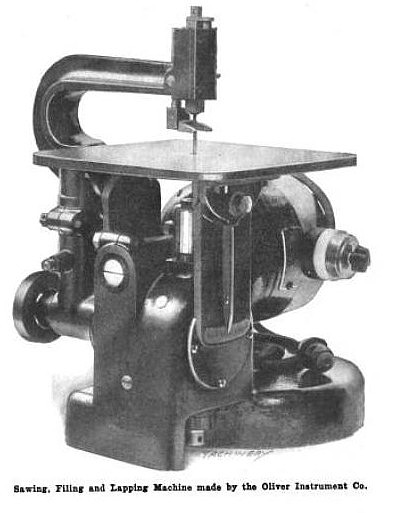|
Title: |
1915 Article-Oliver Instrument Co., Sawing, Filing & Lapping Machine |
|
Source: |
Machinery Magazine Dec 1915 pg 345 |
|
Insert Date: |
3/31/2011 7:23:40 PM |
For use in shops engaged in the making of dies or instruments, or for shops where experimental work is being done, the Oliver Instrument Co., Detroit, Mich., has developed the sawing, filing and lapping machine which is illustrated and described herewith. It is particularly adapted for following irregular outlines; for instance, In making a blanking die the stock is removed by sawing out the material close to the outline, leaving an opening with the proper clearance and with a minimum amount of metal to be removed by filing. It will be evident from the illustration that the desired clearance is obtained by setting the table to the proper angle. An over-arm supports the saw or file at the upper end to prevent it from being deflected from the work.
Another typical application of the machine is in sawing out plain or Irregular shapes from sheet metal or flat stock, and after the sawing operation has been completed such parts may be finished to exactly the required outline by filing. The correction of an Inaccuracy in a hardened die or similar part
may be mentioned as a typical example of the application of the machine for the performance of lapping or stoning operations. For this purpose, either a lap or a special oil-stone may be employed, which is so supported that the maintenance of the proper clearance angle and straightness of the work Is assured.
The saw, file or lap used on the machine is clamped In a special collet carried by the lower ram, and the upper end is held and guided by a similar collet mounted in a slide that reciprocates in the over-arm. The over-arm does not reciprocate, and a coil spring acts on the slide to provide an initial tension on the saw blade. The tool may be quickly released from the slide and the over-arm swung to one side to provide for removing or replacing work on which It is necessary to operate in a hole in the center of the work. Special reinforced oil-stones have been developed for use on this machine, which are held and guided in the same way as the saws and other tools. When used as a filing machine, the over-arm may be used as an upper guide for thin files or where extreme accuracy is required; or it may be swung aside or entirely removed when the machine is handling rough work.
Either a direct or alternating-current motor may be provided for driving the machine, and It Is direct-connected and entirely enclosed to exclude filings, dust and other foreign material. The power is transmitted through steel spiral gears, and the crankshaft is supported by a ball bearing, which takes the thrust of the ram. The reciprocating parts are carefully balanced. The ram guides are made of cast iron and the upper guide is a separate unit, made of close grained cast iron, so that it may be replaced if necessary.
The table is 9 inches square and may be tilted to any angle up to 10 degrees in either direction from the horizontal position; it Is clamped in any position by means of two bolts. The angle to which the table has been set is clearly indicated by a large scale and pointer, which are shown in the illustration. A locating pin Is provided, which facilitates bringing the over-arm Into alignment with the lower ram, in which position it is securely clamped by a bolt. All gears, shafts, bearings and other parts of the drive are enclosed and run in oil; and the construction is such that dust, chips or other foreign matter cannot find their way into the mechanism. The equipment of the machine Includes two upper and two lower collets, three oil-stones, a set of files, and a wrench for making all adjustments. |
|
 1915 Oliver Instrument Co., Sawing, Filing & Lapping Machine
1915 Oliver Instrument Co., Sawing, Filing & Lapping Machine
|
|